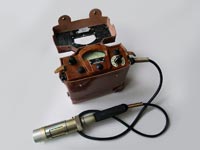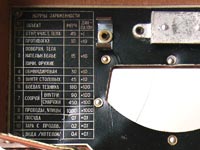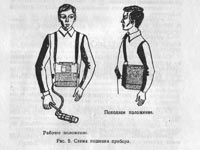 |
DP-5 - undoubtedlythe most mass Soviet military radiometer - roentgenmeter (ionometer). It was developed in 50th years of the last century and, in various modifications, has successfully lived up to now. The version with a letter “A” – was naturally the very first. Then would follow, “Б”, “B”, “M” -(medical) and the latest “BБ”.
Years wentby. On change to valves transistors, then microcircuits, then microcontrollers have come... And DP-5 remained such as was. Only small cosmetic changes. Have slightly changed the scheme, in the version "B" have removed the gammaradiation detector built in the case, and the case began to made of more modern and strong plastic, have rearranged control strontium-yttrium source from the device case on the case of the block of the detector. Have changed the tableton a cover inside (have entered there more sparing "norm of contamination"). Thats actually was all the innovations.
The electric circuit of the device is to the limit simple, and using the device does not demand serious preparation: "switch on and measure". Anyway, the device was developed for army, therefore is not intended for exact measurement, and is rather for a rough estimate in severe military settings: "much or few" (over or under). About it tells much: rude pointergage, nonsensivity to levels is less then 50 µR/h. Especially pronouncedly itis visible on an example of measurement of beta pollution. Yes, DP-5 have such possibility and on the detector block is corresponding of the beta filter... But a scale graduated in mR/h and R/h. Therefore the beta-particles flux density is measured as a difference in instrument reading swith the beta filter and without it at level: "is or not" and"much or a little".
 |
There are only four items of management of the device: the switch of a choice of the range, combined with the switch and calibration, the handle of the calibrating resistor, the button of compulsory reset of indications and the toggle-switch of illumination of a scale. The detector block (in versions "A" and “Б” it was named a probe) consists of two gas-discharge detectors (STS5 and SI3BG). One more SI3BG is in the case of the device and works on the upper most range to 200 R/h. In the version "B" the detecting block consists of two gas-discharge detectors SBM20 and one.
 |
A feed of the device from three accumulators 1,6 ПМЦ-Х-1,5 (КБ-1) (one is used for scale illumination). It is unreal to find today such "ancient" batteries, but with a simple updating, it is possible to use the usual batteries of АА type.
There are no censures to quality of assemblage. What the hell, say that one will, formerly were able to do reliable and durable things! And though the case material has been replaced in the subsequent updatings on more technological and shockproof, this "red monolith" is really not easy to damage. Well certainly there are all necessary joint scaling inserts and rubber caps - drip-proof. The portable block of detecting - is leakproof.
- Specifications
|
Measurement range and Basic relative error:
|
||
| - Gamma and X-ray radiation equivalent dose rate (137Cs) |
mR/h
|
0,05…2.105;
±30% |
|
Energy ranges of measurement and energy dependence:
|
||
| - Gamma and X-ray radiation |
MeV
|
0,084…1,25;
|
| - Storage battery life
|
hours
|
40
|
| - Operating temperature range
|
°С
|
-40…+50
|
| - Weightof the device
|
kg
|
2,8
|
To workwith the device is easily. The first click by the switch - switching on andcalibration (with the variable resistor you expose an arrow opposite to aspecial mark in a scale), the second - switching on the uppermost range up to200 R/h, if the arrow does not move, you switch further to the bottom rangeswhile the arrow will not move a little. That's all. For check of a presence ofbeta pollution: on a probe the window opens. Also there is a control strontium-yttriumsource for working capacity check. In the version "A" it is on a folding cover of the device and it is closed by a cover. The source, as well as the device already is 40 years old, but despiteon such "age" the beta-particles flux density from it is about 80 thousand CPM.
 |
That is good: simplicity, reliability, good search possibilities; the indicating device, by my opinion, is more convenient for a fast estimation of level, than a digital board.
That is not good: it would be possible to list a lot. Inaccuracy, manual switching of ranges, weight, impossibility of an exact estimation the beta-particles flux density... But I do not see in this any sense. This device is developed half a century ago and to estimate it, it is possible only from a position of a dosimetric equipment, dosimetry of that time and army, general purpose.
The resume.
People often ask my opinion about DP-5. How good the device is? Is there any sense in its purchase, and usage? The first, that I’ve ask in such cases: for what you need it? What you are intend to measure with it? DP-5 was developed in those days when on levels of EDR less then 10 mR/h anybody even don’t pay attention. Usage of a device makes sense in case of nuclear war or radiating accident, scale of Chernobyl, when there is no special sense to specify 100 µR/h there, or 101 µR/h, no sense to count up with rigor every beta particle on square centimeter per minute. Other approaches, other measures: to measure quickly, even if rough, but first of all quickly, "norms of contamination" - look the table on a device cover, the manual - in the same place, on a cover.
From a position of today this device not the measuring instrument, but rather a signalling device. Professionals have newer, more exact modern technics. But in an everyday life, is it really necessary for you to walk with the radio-activity signalling device 3 kg in weigh, with the external detector? If wish to make sellers on a market nervous by measurement of apples and potatoes about radiation is so strong, may be it makes sense to get something modern and not so bulky? :)
DP-5 is a worthy device of its time. He fairly worked not one decade, including on liquidation of consequences of failure on ChNPP in 1986. Perhaps its time has passed, but it still can be useful in extreme conditions of high levels of radiation.
Author: Yevgen "KRANZ" Goncharenko
| Gamma Scout< Prev | Next >Dosimeter MKS-U |
|---|








